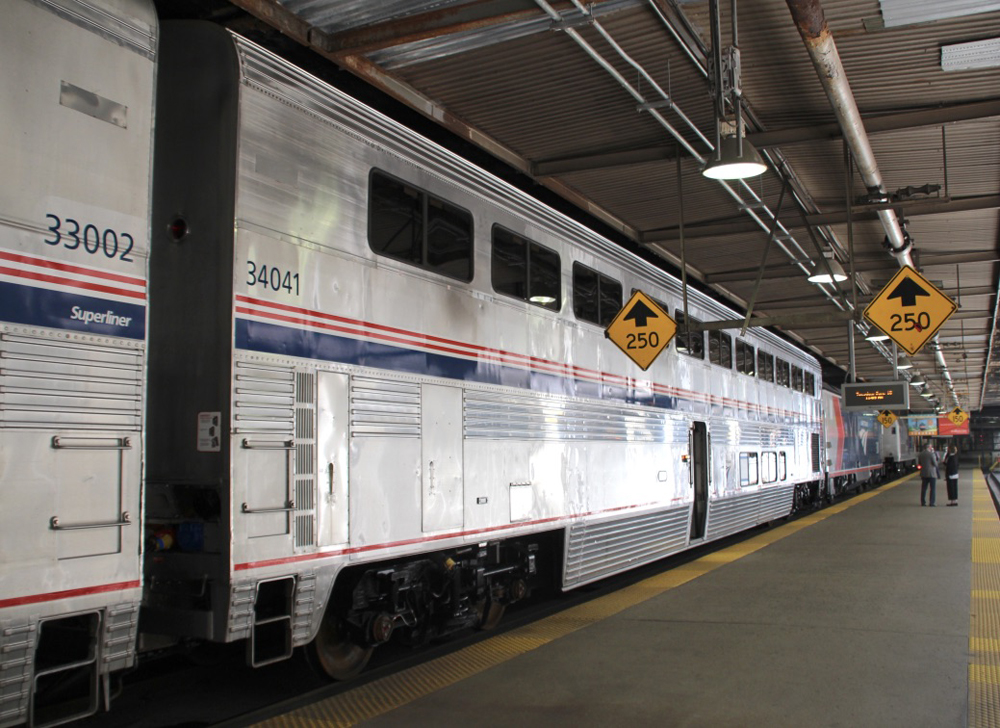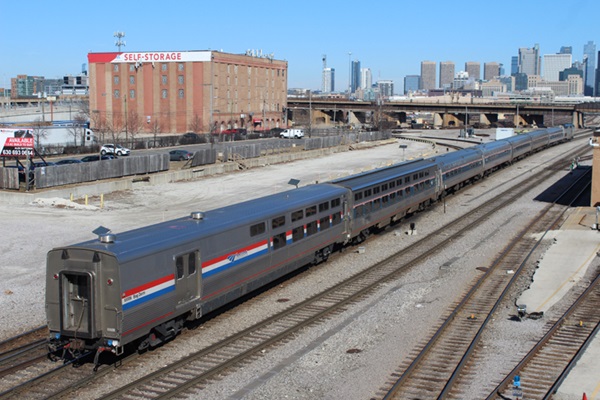
WASHINGTON — Amtrak has issued a formal Request for Proposals for replacement of its bilevel long-distance railcar fleet, outlining requirements for what it says will be a multi-billion-dollar order for equipment projected to enter service in the early 2030s.
The document, which outlines for manufacturers requirements for coach seating, sleeping cars, food service, and accessibility, is not publicly available. It follows a Request for Information issued in December 2022 [see “Amtrak seeks carbuilder interest …,” Trains News Wire, Jan. 19, 2023]. Amtrak says responses to that request helped shape the Request for Proposals; the company also held a public hearing in August to gather comment on accessibility issues [see “Amtrak reveals new long-distance trainset concepts …,” News Wire, Aug. 30, 2023].
Responses from manufacturers are due by May 17, 2024. The request is for bilevel equipment, “as it is Amtrak’s highest priority to replace the oldest portion of the long distance fleet,“ Amtrak spokesman Marc Magliari said in an emailed response to questions from Trains News Wire. Specific numbers of car types, as well as details on “classes of service, onboard amenities, and customer enhancements will be determined based on capabilities of the car builders.“ Those details will be made public once a manufacturer is selected. The plan is to order trainsets rather than individual cars.
“Procuring new equipment for our Long Distance trans is a one-in-a-generation opportunity to reimagine our iconic routes through a modern, accessible, and sustainable fleet,” Amtrak President Roger Harris said in a press release. Said Tony Coscia, chairman of the Amtrak board of directors, “A new Amtrak Long Distance fleet will help us modernize and transform the service to meet the needs of customers now and into the future.”
Amtrak’s last order for long-distance equipment was for 130 single-level sleeping, dining, baggage-dormitory, and baggage cars built by CAF USA, a $298 million contract awarded in 2010 that took more than a decade to complete; the final cars were delivered in August 2021. The baggage cars see service nationwide, while the sleepers and dining cars are used in the eastern U.S. Nine long-distance routes are handled by Superliner equipment, bilevel cars built by Pullman-Standard and Bombardier. The first of those cars entered service in 1979 and the most recent were built in 1996; gradual reduction of that fleet through losses to derailments and other issues has created capacity issues for many of the Superliner-equipped trains.
— Updated at 4:30 p.m. CST with additional details.















Mr. Sanchez: You have been here before, although not in a while in my reading, always shilling for Amtrak. Five issues I’ll present you, Mr. Sanchez:
How about you, and those folks at NARP/RPA who are also nothing more than Amtrak shills, address Neil Lang’s accusation that a goodly percentage of the Viewliner sleepers and diners were sent into storage right from the builder and have never turned a wheel in revenue service. I’ve seen that accusation before but never any proof/documentation. If true that’s a damning indictment. What say you?
How about Gardner’s and Harris’ decision to go out for new LD cars that will once again not allow the flexibility to operate anywhere in the country.
Hi-level equipment also makes it much harder to satisfy ADA requirements.
It is planned to have elevators for ADA passengers to access the upper level. This is NUTS!!! What happens when the elevator(s) goes bad order close to leaving time at the train’s originating station? What happens when they fail out on the road? Then the ADA passengers on the upper level are trapped. And after all the well-documented equipment failures both in the terminals and out on the road, of don’t tell me those elevators won’t fail.
And then Gardner’s and Harris’ decision to go with fixed consists rather individual cars. You know why they did that? Because they want demand to outstrip capacity so they can Jack the fares into the stratosphere, show growing revenue, and grant themselves huge bonuses as reward for growing the revenue.
And Gardner and Harris know no one’s watching. Certainly not SecTrans Buttigieg. Certainly not FRA administrator Amit Bose.
How about the ultimate true double-deck train set:
https://www.yumpu.com/en/document/read/27033561/talgo-22
I think the train you linked looks more suitable for commuter service than Long Distance Service but perhaps it could be modified.
The last paragraph mentions”Amtrak’s last order for long-distance equipment was for 130 single-level sleeping, dining, baggage-dormitory, and baggage cars built by CAF USA,”. What is not mentioned is how many of these 130 cars are being stored in Hialeah and other facilities rather than being put into service.
They’ll have a mountain to climb to meet or exceed the durability of the Superliner series…I hope Amtrak used those as a benchmark, of course adding what needs to be added.
Complain? Yes I’ll complain. Nothing is getting done in this country. While Mayor Pete’s only focus is his plans to tear down Detroit’s Walter P. Chrysler Freeway (for reasons unfathomable), we can’t build a rail car that can get down the track.
Really, nothing?? Portal Bridge, Baltimore tunnels, Susquehanna Bridge, Walk Bridge, DC Long Bridge, Gateway tunnels and approaches–all are now underway. I can see, as well, that there is more to be done, but to say that nothing is happening seems off the mark.
Good points Lawrence. Every project you mention is valid, all of them in NEC, none using Superliners.
A pathetic commentary on Amtrak Joe and Amtrak itself. Politicians and their appointed hacks kicking the can down the road, like the 65 corridor studies.
Most significantly it reflects the engineering and manufacturing expertise of the US in general. How long did it take to field the Zephyrs, FT, Hudsons, California Zephyr or El Capitan? Pathetic.
Maybe I’ll see these cars before I die, but I’m not holding my breath.
If there are “capacity issues for many of the Superliner-equipped trains,” then why is the plan to order “trainsets rather than individual cars?” So there will always be capacity issues at peak times? Oh, wait a minute – it’s part of reimagining iconic routes. I get it.
Once again, so much complaining. Do any of you ever have anything positive to say about anything?
Think about it the next time you vote for Congress and for President. Is the person you’re voting for going to oppose Amtrak funding and capital expenditures? If so, then maybe you’re not voting in your own best interest. All of the current Superliner equipment was designed during the Carter Administration.
Various administrations gave Amtrak next to nothing for capital expenditures.
It shouldn’t take over a decade to design, order, and construct.
I think there is a general thought of cynicism when it comes to Amtrak and doing RFP’s for design build *anything*. The pattern is always the same, overweight, overbudget, overtime. If Amtrak could get a track record of success behind them, people would probably lose their attitude.
As for the glory years of passenger rail supply, the issue is there is only ONE major buyer for LD trainsets. What we really need is more competition in the passenger sector. More competition, more needs for builders to come up with innovative designs.
Privitize passenger rail and turn Amtrak into an FAA oversight authority. Put routes up for bid that buys a time slot, a station slot, and Amtrak liability.
This will drive innovation into the equipment space.
Yes there is cynicism. How are Amtrak LDs better now, after half a century, than the 1960’s western transcons were? Answer: computerized reservations. In 1972, it took me an effort to get a ticket on an “Amtrak” train which was a Santa Fe train by another name. Now anyone can get a ticket a few minutes clicking on the Internet.
That’s all we have to show for half a century. The train isn’t any better. The train isn’t even as good. In fact Amtrak 3/4 is a shadow of what Santa Fe offered, quality of trains, reliability, and the quantity of routes and frequency.
Al DiCenso’s post on this thread is correct. There’s no need for the new cars. Amtrak’s LDs have a few years left then they will be gone.
It’s not all Amtrak’s fault. The railroads have changed. Today’s CSX across New York State and to Chicago isn’t the same railroad as the New York Central was. If EHH had had his way it would have been single-tracked. Fortunately he was gone before that happened.
Who are they kidding? At the rate they’re shrinking trains, cutting back services and generally ticking off customers, there won’t be any demand for long distance services by 2030. Bah, humbug!
Ridership on these trains has been increasing these past years, a trend likely to continue. Besides, Amtrak is spending millions refurbishing cars (they are bringing back 65 or so into service in FY 24), improving bedding and dining, and marketing these trains. Congress has also made clear their intentions that these trains be operated.